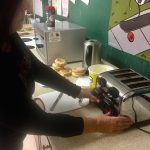By Olivia Timm [6]
PICTON – Every morning, Karen Cowan and Lori Harrison come into Queen Elizabeth Public School to make sure students will have a healthy breakfast before they start their day.
Early this past Tuesday morning, the two educational assistants were toasting English muffins, setting out cups of milk and clearing off tables. The students arrived a few minutes before 8 a.m., tossing off their coats and backpacks in their classrooms and rushing down the hall to the Breakfast Club room, excited to come in for yummy, healthy food.
The kids know the drill – line up, grab something to eat and drink, and mingle with friends before the morning bell.
“They are excited … We can have up to 30 students in this room, and it is like a little social gathering,” Cowan said. “We see them talking and sitting together, maybe even with students they do not normally see in the classroom, but they see them here.”
“It’s like a breakfast family,” added Harrison.
Financial support for the breakfast program at Queen Elizabeth and schools throughout Hastings and Prince Edward counties comes in part from the Feed The Meter campaign, which runs for the month of December in Belleville, Picton and Trenton.
Parking is free in the three downtown areas during the holiday season, but people are encouraged to put money into the meters to support the Food for Learning program.
The campaign kicked off last Friday with a breakfast launch at the Greek Community Hall in Belleville, where people were invited to a short presentation and to make donations to Food For Learning. Mayors Jim Harrison of Quinte West, Robert Quaiff of Prince Edward County and Taso Christopher of Belleville unveiled a cheque for almost $240,000 – the amount of money the Feed the Meter campaign has raised over nine years.
Maribeth deSnoo, executive director of the Hastings-Prince Edward Learning Foundation [7], says people know that the money they’re donating stays in the community and goes toward a good cause, which is why they continue to donate even when parking is free downtown.
Hastings and Prince Edward counties are above the Ontario average when it comes to families who struggle with not having access to enough healthy food, deSnoo said.
During the 2016-17 school year, the campaign provided over one million snacks and meals, which fed around 13,000 kids, she said.
The goal for Feed The Meter [8] this year is $30,000.
Kellie Brace, the Food For Learning co-ordinator at the foundation, said that at a cost of $1.23 for an average breakfast, Feed The Meter will raise enough for 36,900 meals and snacks if the goal is met.
Food For Learning [9] programs are open to all schoolchildren, she said.
“There is plenty of food in my fridge, but my daughter, from the time she was in kindergarten, has dropped into Food For Learning programs at her school because I told her it is okay to go,” Brace said. “It became a very socially healthy way to start their day.”
The point is to give kids a healthy breakfast, snack or lunch so they have the energy necessary to learn. However, the program also allows kids to learn leadership skills by helping set up breakfast or snack baskets, and to learn healthy eating habits early on, according to Brace.
School board community development co-ordinator Vicky Struthers agreed that the program is for all children in the school.
“Food For Learning is about feeding everyone. It’s universally accessible, it is in every school, it follows nutrition guidelines … it is a healthy start for healthy minds.”
Food For Learning started in 2000, and now every school in Hastings and Prince Edward has at least one kind of program, whether it’s breakfast, snack, lunch or a combination. This means that a full generation of kids has had access to the program in their school, Brace said.
“There is nobody in school right now who has not been familiar with a Food For Learning program … If they started going in kindergarten, and they don’t know anything else except that it is part of their school culture, I think that we are headed to a time where that stigma (around children using the program because they aren’t being well-fed at home) is gone,” she said.
It’s impossible to tell why each student is lining up for the healthy food, Brace said: Were they rushing to get ready and didn’t have time to eat? Did they forget their lunch while walking out the door? Did they eat two hours ago and feel like a snack to tide them over? Food For Learning operates in a way that not only helps kids who do not have enough to eat at home, but makes them feel comfortable enough to attend since they are not singled out, she said.
“A really nice side effect of a universally accessible program is that we are catching those kids who are experiencing food insecurity because they know they are not going to need to identify as being different for participating.”






